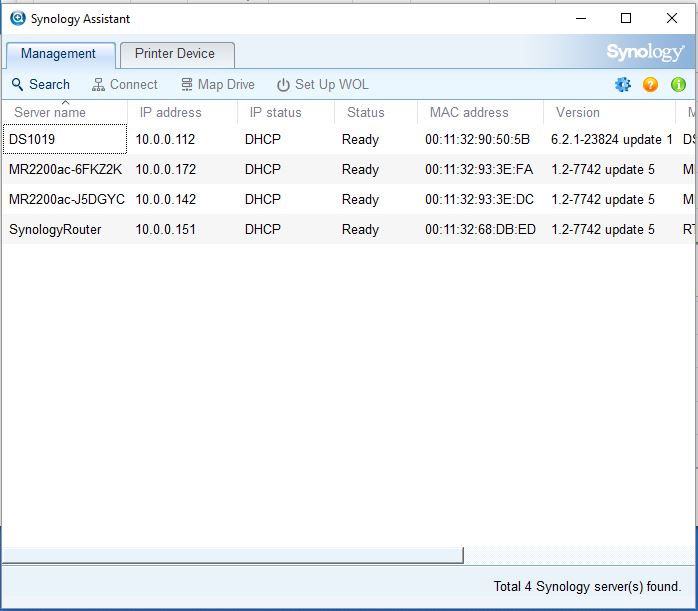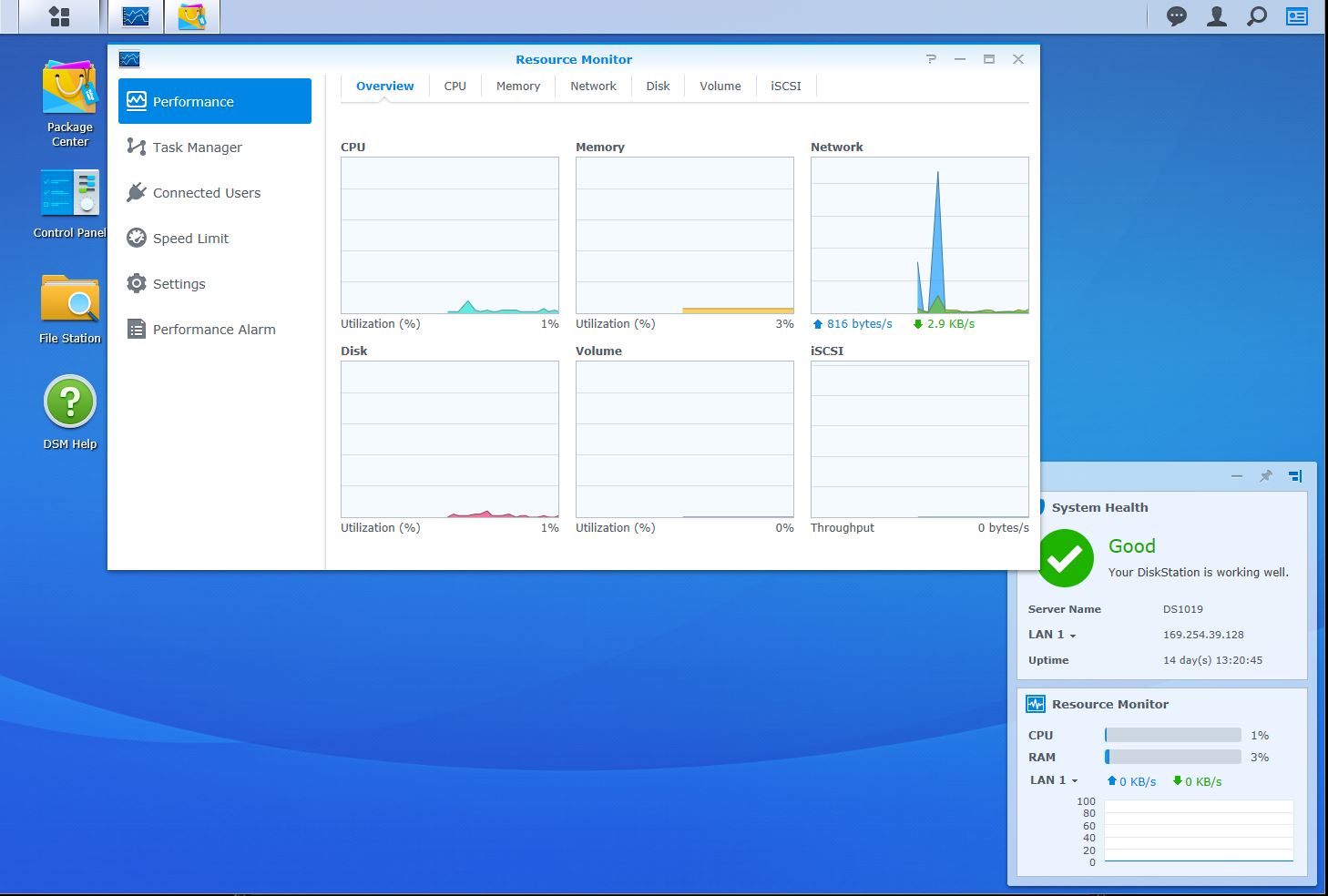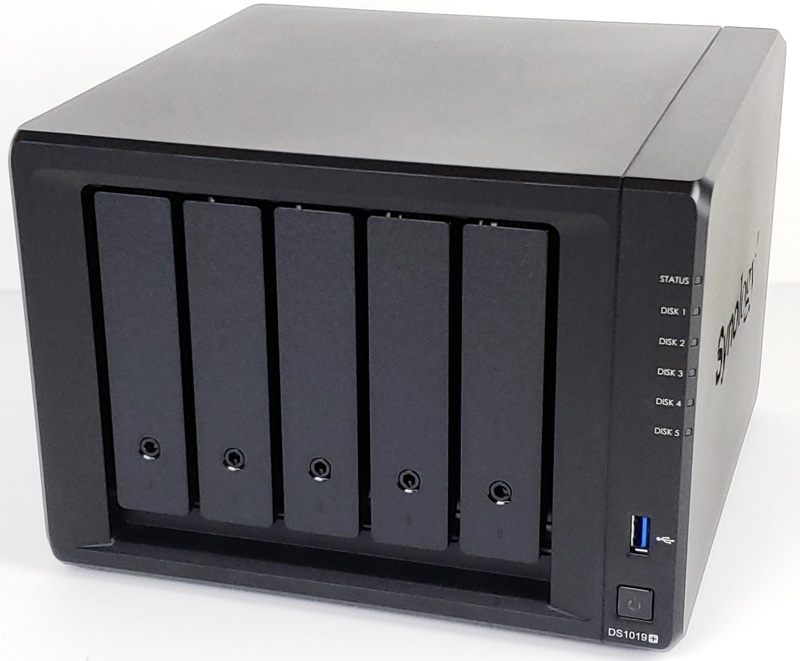Synology DS1019+ 5-Bay NAS Management
Getting our Synology DS1019+ up and running is the same as the DS918+, and DS1618+ we reviewed earlier. Synology administrators will feel right at home with the process.
On your computer desktop download and install Synology Assistant, this will then bring up a list of Synology products on your network.

Here we see Synology Assistant showing our Synology products on our network. Our Synology DS1019+ shows up as DiskStation, in our picture we had already set up and named our NAS.

Synology’s latest DiskStation Manager (DSM) is shown here up and running after our installation is complete. We have the resource monitor open in this screenshot.
Synology has a wide range of applications that can be accessed via the GUI. For the SMB market, these make a lot of sense. We have covered these applications in a number of reviews and are not going to revisit them. Suffice to say, for many SMB shops Synology units can perform much more than simple NAS functions and also serve as local servers.
Final Words
When we compare specifications between the DS918+ and DS1019+, we find them to be nearly identical except for the extra drive bay located on the Synology DS1019+. As we would expect, performance between the two is very similar in both standard and encrypted use. We added in the Synology DS1618+ to show that even going to 6-Bays, performance is being limited by 1GbE. While the DS1618+ offers an additional upgrade path consisting of an extra HDD bay and PCIe slot for M.2 cache or 10GbE network cards, if you choose the Synology DS1019+ you are focused on 1GbE networking for the life of the device.

With the DS1019+ and the extra HDD bay, one can add additional storage capacity and have an odd number of drives for RAID 5. For RAID 6 or RAID 10, one can even have a spare drive which can save field maintenance for SMB and branch office installations where truck rolls are expensive.
Both the Synology DS1019+ and DS918+ include two 1GbE network ports; giving the user an option of using Link Aggregation Control Protocol (LACP) if they have a network and clients that support this feature. Doing so can boost your network speed to 2GbE. Of course, all clients connected to the network would need two 1GbE aggregated to get 2GbE speeds and one would need a solid set of parallel data streams or multiple clients. Out of the three NAS’s we used here only the DS1818+ can use 10GbE via a network expansion card.
At the time of writing the Synology DS918+ retails for around $549.99 and the DS1618+ retails around $749.99 without expansion cards. Priced in the middle of those two options, you have a good sense of how much it costs to attach an additional drive to a network by moving from 4-bay to 5-bay. Currently, the DS1019+ is going for $649.99.
With most Synology units, the software is extensive and easy to use. There are many SMB shops out there that simply need a five-bay NAS solution. That adds significant storage at relatively low costs and opens up more configuration flexibility. Here the Synology DS1019+ does well and will service the Synology community in that capacity.




It’s just a bummer that they don’t offer caching AND 10GbE anywhere in their lineup (unless I just haven’t found it yet). I wonder how much the caching on this one would help with just 1GbE.
@Eddie, they do have NVME + 10Gb (via addon-card) … it’s the RS1619xs and is $2000 sadly.
Yeah they really need to have an option to add 10Gb to their other NAS that support NVME. Or add NVME support to their NAS that already support 10Gb addons.
QNAP have an offering but they don’t have all the software that I require that Synology’s DSM has available.
Samba with SMB3 will benefit just fine from having LACP links AFAIK, but that’s just a measly n x 110MB/s in ideal conditions. Other protocols unable to use multiple connections/streams (that can benefit from LACP hashing at L3 level) won’t benefit. It’s definitely dumb but the problem is lack of PCI lanes…
Can it be ran in raid 1+0 (raid 10) with 4 bays and the 5th bay having a drive in it for automatic disk rebuilding when one of four being used fails?
Robert – yes.
When you have 5 bays available, is it not better to run it in raid-5 mode ? will it not be the fastest and most failure proof ?
Of course running with an UPS unit… so much data with possibility to corrupt … :(